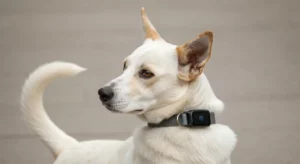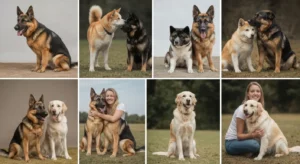(SAN FRANCISCO, CA) — A new trend is captivating pet owners across TikTok, flooding the platform with videos of dogs and cats seemingly reacting to their owners’ expressions in a mirror. Dubbed the “#PetEmotionMirror” challenge, the viral phenomenon has amassed over 800 million views in a matter of weeks, but as its popularity soars, veterinarians and animal behaviorists are urging caution, sparking a debate about whether the trend is a harmless bonding activity or a source of unperceived stress for animals.
The challenge is simple in its execution: an owner positions their pet in front of a mirror, then makes a series of exaggerated facial expressions—from a wide, joyful smile to a sorrowful frown. The goal is to capture the pet’s reaction, with many videos appearing to show animals “mirroring” these human emotions. The resulting clips, often set to trending audio, range from heartwarming to comical, fueling their rapid spread across the social media landscape in late 2025.
What is the #PetEmotionMirror Challenge?
Participants in the viral pet challenge on TikTok typically hold a small, handheld mirror in front of their dog or cat. While the pet looks at its reflection, the owner, positioned just out of the pet’s direct line of sight but visible in the mirror, cycles through emotions. Some of the most popular videos feature dogs that appear to whimper when their owner feigns crying or cats that seem to narrow their eyes when their owner squints in concentration.
The hashtag has become a hub for a global community of pet lovers sharing these moments. Many users caption their videos with sentiments like, “He feels my pain,” or “My dog is so emotionally intelligent.” This narrative of deep, empathetic connection is central to the challenge’s appeal, suggesting that pets possess a human-like understanding of our feelings.
The Data Behind the Trend
The explosive growth of the #PetEmotionMirror challenge highlights a significant shift in how owners engage with their pets online. According to a report released this month by SocialPet Analytics, a firm that tracks digital pet-related trends, uploads using the hashtag have increased by over 500% since October 2025.
“We haven’t seen a pet trend achieve this level of organic velocity since the ‘doggie dancing’ craze of 2023,” commented Mark Chen, lead analyst at SocialPet Analytics. “The visual element is key, but the emotional hook—the idea that you’re revealing a hidden depth to your pet’s personality—is what truly drives the engagement.”
A snap poll of 2,500 pet owners conducted by the American Pet Owners Association (APOA) in November 2025 provides further insight. The survey found that among those who had tried or considered the challenge:
- 65% participated for “lighthearted fun and entertainment.”
- 28% believed it was a “new way to bond and interact” with their pet.
- 7% were hoping to create content that would go viral.
This data suggests that for the vast majority of participants, the motivation is rooted in a positive desire for connection, not just a quest for online fame.
What Experts Are Saying: A Clash of Perspectives
While the videos may be charming, animal behavior experts are quick to point out that what owners are interpreting as emotional mirroring is likely a misreading of animal communication. They argue that the trend, though well-intentioned, is built on a foundation of anthropomorphism—the attribution of human traits and emotions to animals.
The Behavioral Science View
“Dogs and, to a lesser extent, cats are masters at reading human body language and tone of voice,” says Dr. Anya Sharma, a certified animal behaviorist and author of the book The Canine Compass. “When an owner frowns and speaks in a sad tone, their dog isn’t feeling existential sadness. It’s more likely responding to familiar cues that it has learned to associate with a certain outcome, such as receiving comfort or a treat.”
Dr. Sharma explains that a dog’s “sad” whimper might be an appeasement gesture, an attempt to pacify what it perceives as a distressed owner. “They are incredibly attuned to us, but their internal experience is different. The mirror adds another layer of confusion. Most animals don’t have self-recognition in the same way humans do. The pet is reacting to the owner’s cues and the strange image in the glass, not having an empathetic epiphany.”
The Veterinary and Welfare Angle
From a welfare standpoint, the primary concern is the potential for stress. Many of the behaviors that owners interpret as cute or funny can be subtle signs of anxiety.
“A lot of owners filming these videos are missing classic stress signals,” states Dr. David Rodriguez, a veterinarian at the Animal Medical Center of New York. “In dogs, we’re seeing frequent lip licking, yawning when not tired, and ‘whale eye,’ where the whites of the eyes are visible. In cats, pinned-back ears, a low, twitching tail, and attempts to hide are clear indicators of discomfort.”
Dr. Rodriguez stresses that for an already anxious animal, being held in place and confronted with a confusing stimulus can be a significantly negative experience. “For a confident, easy-going dog, a 30-second interaction might be harmless. But for a rescue cat with a history of trauma, it could be terrifying. The problem with a viral pet challenge on TikTok is that it doesn’t come with a disclaimer that says, ‘Know your pet’s specific temperament and boundaries.'”
The Owner’s Perspective: Connection or Content?
Despite these expert warnings, many pet owners who participate in the trend see it differently. Jenna Carter, a pet influencer whose video of her Golden Retriever, Gus, “frowning” in a mirror received over 2 million likes, defends the challenge as a harmless interaction.
“Of course, I don’t think Gus is pondering the complexities of human sadness,” Carter said in an interview. “It’s a game. It’s a moment of focused, one-on-one time that we both enjoy. People are reading too much into it. The community that forms around these videos is incredibly positive. We’re all just celebrating the special, sometimes silly, bonds we have with our animals.”
This sentiment is echoed in thousands of comments on the platform, where users share stories of their pets’ unique personalities. For many, these trends are less about scientific accuracy and more about participating in a shared cultural experience that puts their beloved companions in the spotlight.
Guidelines for Safe and Responsible Participation
For owners who still want to try the #PetEmotionMirror challenge, experts suggest a framework that prioritizes the pet’s well-being over the perfect video clip. The consensus is that if you choose to participate, it must be on your pet’s terms.
1. Know Your Pet’s Personality
Is your pet generally confident and outgoing, or shy and easily stressed? If your animal shows any signs of anxiety around new objects or situations, it’s best to skip this trend entirely.
2. Learn to Read Their Body Language
Before you even pick up a mirror, educate yourself on the specific stress signals for your pet’s species. For dogs, this includes panting when not hot, a tucked tail, and avoiding eye contact. For cats, watch for hissing, growling, dilated pupils, and flattened ears.
3. Keep Sessions Short and Positive
The interaction should last no more than a minute. Keep your tone light and positive, even when making a “sad” face. Reward your pet with praise and a high-value treat for their calm participation. Never restrain your pet or force them to stay if they try to leave.
4. End on a Good Note
After the interaction, engage in an activity your pet genuinely loves, like a game of fetch or a relaxing petting session. This ensures the experience is associated with a positive outcome.
The Bigger Picture: Social Media and Animal Welfare
The #PetEmotionMirror challenge is the latest in a long line of trends that place animals at the center of online content creation. While many are benign, others have raised serious welfare concerns in the past. This dynamic places a new level of responsibility on the modern pet owner.
“The desire to share our lives with our pets online is a wonderful thing, but it has a potential dark side,” says Dr. Elena Vance, a sociologist at Stanford University who studies human-animal-technology interactions. “The line between sharing a moment and exploiting an animal for ‘likes’ can become blurred. These viral challenges serve as a crucial test case for our collective digital ethics as pet owners.”
Ultimately, the decision to participate in any viral pet trend rests with the individual owner. By putting education and empathy first, owners can ensure that their quest for the perfect post never comes at the expense of the animal they love. The real challenge, experts suggest, is not to see if a pet can mirror a human emotion, but whether humans can accurately interpret and respect their pet’s true feelings.












